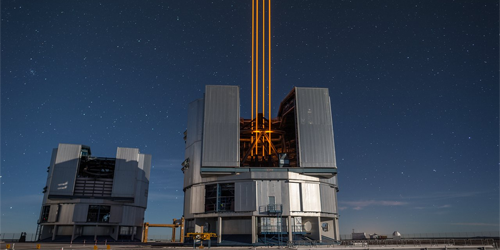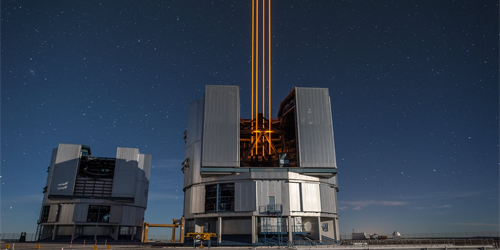Laser Stars Under the Lens
“Laser guide stars” are an astronomer’s best friends. Created by directing laser light into the sky and making sodium atoms in Earth’s upper atmosphere glow, they help astronomers measure and correct for the effect of atmospheric turbulence on astronomical observations. Frédéric Vogt and colleagues from the European Southern Observatory (ESO), in Chile and Germany, now characterize a previously overlooked source of contamination for observations that rely on these artificial stars: laser-induced Raman scattering.
It is known that, when using laser guide stars, some of the laser photons are scattered by air molecules on their way up to the upper atmosphere. But until now, astronomers have largely ignored Raman scattering, in which photons lose energy by exciting molecules to higher vibrational levels. That’s mainly because Raman-scattered laser photons are in the visible wavelength range, whereas most astronomical spectrographs equipped with laser-guide-star technology operate in the infrared regime. But as observatories start using this technology with optical spectrographs, laser-induced Raman scattering needs to be characterized.
This is exactly what Vogt and co-workers did. The team used the MUSE optical integral field spectrograph mounted on the Very Large Telescope at ESO’s Paranal Observatory in Chile to record the spectra of the “uplink” laser beams associated with a laser-guide-star system recently installed at the telescope. The measurements revealed clear spectral lines due to Raman scattering by atmospheric molecular nitrogen, molecular oxygen, carbon dioxide, and water. And there were also hints of a line from methane. These Raman lines could contaminate the spectra of astronomical objects. The results are thus a cautionary tale for observatories that employ laser guide stars.
This research is published in Physical Review X.
–Ana Lopes
Ana Lopes is a Senior Editor of Physics.





